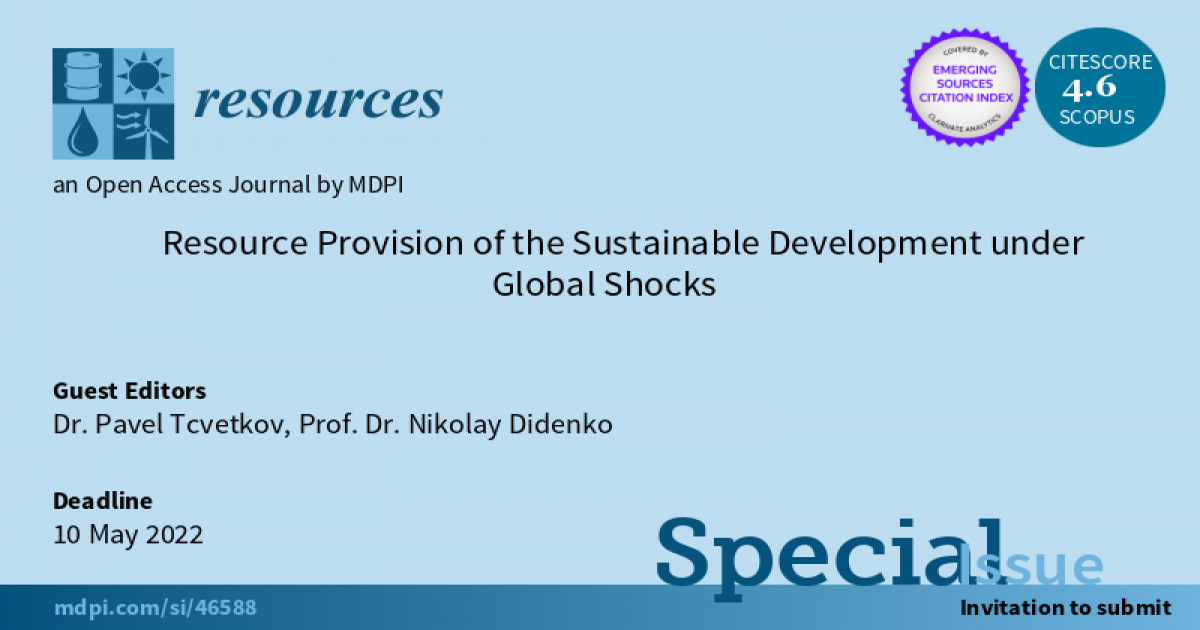- 3.2Impact Factor
- 7.2CiteScore
- 24 daysTime to First Decision
Resource Provision of the Sustainable Development under Global Shocks
Special Issue Information
Dear Colleagues,
Sustainable development is a central concept for global growth in the foreseeable future. Such growth, on the one hand, requires the provision of significant resources, including financial, technological, social, and natural resources. On the other hand, it should provide stability of the global economy for various markets as well as for any unforeseen environmental, political, and economic shocks. To face these challenges, we need to strengthen our knowledge of sustainable development modeling for unstable environments.
This Special Issue aims to collect original research or review articles on the influence of various shocks on the stability and sustainability of global, national, and sectoral economic growth, including social, political, economic and technological aspects. We are also looking for studies modeling the long-term influence of short-term shocks on the deployment of sustainable development principles, forecasts of natural resources supply and demand, and other issues related to the achievement of sustainable goals in volatile environments.
We are also glad to see authors of the selected papers from European Raw Materials Conferences, helded, despite the global shock, entitled COVID-19:
- Russian-UK Raw Materials Dialogue (21-23 October, 2020);
- Russian-German Raw Materials Conference (30 November - 1 December, 2020).
Dr. Pavel Tcvetkov
Prof. Dr. Nikolay Didenko
Guest Editors
Manuscript Submission Information
Manuscripts should be submitted online at www.mdpi.com by registering and logging in to this website. Once you are registered, click here to go to the submission form. Manuscripts can be submitted until the deadline. All submissions that pass pre-check are peer-reviewed. Accepted papers will be published continuously in the journal (as soon as accepted) and will be listed together on the special issue website. Research articles, review articles as well as short communications are invited. For planned papers, a title and short abstract (about 250 words) can be sent to the Editorial Office for assessment.
Submitted manuscripts should not have been published previously, nor be under consideration for publication elsewhere (except conference proceedings papers). All manuscripts are thoroughly refereed through a single-blind peer-review process. A guide for authors and other relevant information for submission of manuscripts is available on the Instructions for Authors page. Resources is an international peer-reviewed open access monthly journal published by MDPI.
Please visit the Instructions for Authors page before submitting a manuscript. The Article Processing Charge (APC) for publication in this open access journal is 1800 CHF (Swiss Francs). Submitted papers should be well formatted and use good English. Authors may use MDPI's English editing service prior to publication or during author revisions.
Keywords
- environment
- fossil fuels
- global shocks
- life-cycle assessment
- natural resources
- policy
- renewable energy
- resource markets
- resources substitutability
- shocks
- supply and demand of natural resources
- sustainability
- sustainable development goals
- sustainable development models
- trends analysis
- technological progress
- triple bottom line

Benefits of Publishing in a Special Issue
- Ease of navigation: Grouping papers by topic helps scholars navigate broad scope journals more efficiently.
- Greater discoverability: Special Issues support the reach and impact of scientific research. Articles in Special Issues are more discoverable and cited more frequently.
- Expansion of research network: Special Issues facilitate connections among authors, fostering scientific collaborations.
- External promotion: Articles in Special Issues are often promoted through the journal's social media, increasing their visibility.
- e-Book format: Special Issues with more than 10 articles can be published as dedicated e-books, ensuring wide and rapid dissemination.

